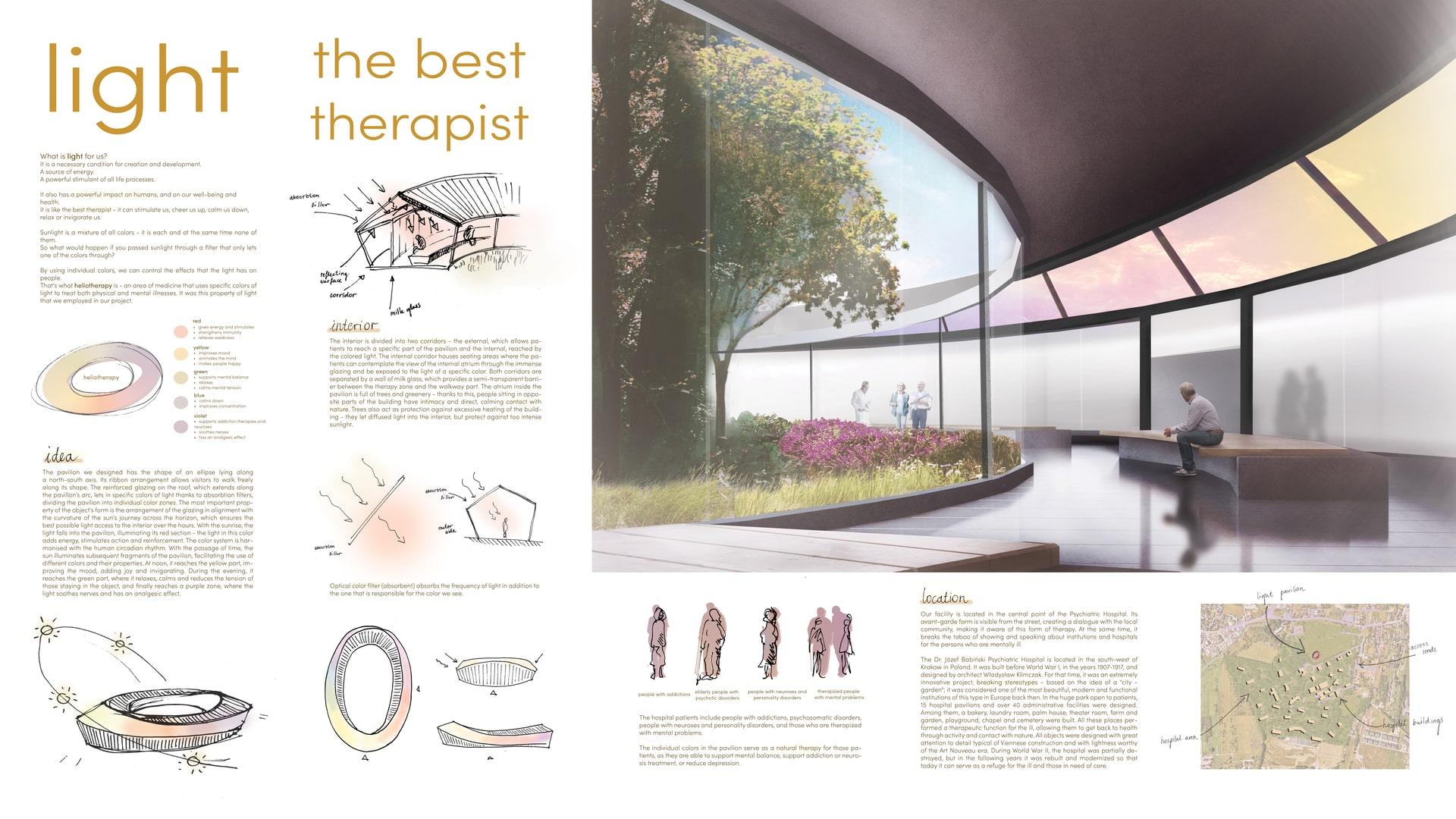Project Description
What is light for us? It is a necessary condition for creation and development. A source of energy. A powerful stimulant of all life processes. It also has a powerful impact on humans, and on our well-being and health. It is like the best therapist - it can stimulate us, cheer us up, calm us down, relax or invigorate us. Sunlight is a mixture of all colors - it is each and at the same time none of them. So what would happen if you passed sunlight through a filter that only lets one of the colors through? By using individual colors, we can control the effects that the light has on people. That's what heliotherapy is - an area of medicine that uses specific colors of light to treat both physical and mental illnesses. It was this property of light that we employed in our project. Our facility is located in the central point of the Psychiatric Hospital. Its avant-garde form is visible from the street, creating a dialogue with the local community, making it aware of this form of therapy. At the same time, it breaks the taboo of showing and speaking about institutions and hospitals for the mentally ill. The Dr. Józef Babiński Psychiatric Hospital is located in the south-west of Krakow in Poland. It was built before World War I, in the years 1907-1917, and designed by Władysław Klimczak. For that time, it was an extremely innovative project, breaking stereotypes - based on the idea of a "city - garden"; it was considered one of the most beautiful, modern and functional institutions of this type in Europe back then. In the huge park open to patients, 15 hospital pavilions and over 40 administrative facilities were designed. Among them, a bakery, laundry room, palm house, theater room, farm and garden, playground, chapel and cemetery were built. All these places performed a therapeutic function for the ill, allowing them to get back to health through activity and contact with nature. All objects were designed with great attention to detail typical of Viennese construction and with lightness worthy of the Art Nouveau era. During World War II, the hospital was partially destroyed, but in the following years it was rebuilt and modernized so that today it can serve as a refuge for the ill and those in need of care. The pavilion we designed has the shape of an ellipse lying along a north-south axis. Its ribbon arrangement allows visitors to walk freely along its curvature. The glazing on the roof, which extends along the curvature, lets in specific colors of light thanks to special filters, dividing the pavilion into individual color zones. The most important property of the object's form is the arrangement of the glazing in alignment with the curvature of the sun's journey across the horizon, which ensures the best possible light access to the interior over the hours. With the sunrise, the light falls into the pavilion, illuminating its red section - the light in this color adds energy, stimulates action and reinforcement. The color system is harmonised with the human circadian rhythm. With the passage of time, the sun illuminates subsequent fragments of the pavilion, facilitating the use of different colors and their properties. At noon, it reaches the yellow part, improving the mood, adding joy and invigorating. During the evening, it reaches the green part, where it relaxes, calms and reduces the tension of those staying in the object, and finally reaches a purple zone, where the light soothes nerves and has an analgesic effect. The hospital patients include people with addictions, psychosomatic disorders, people with neuroses and personality disorders, and those who are therapized with mental problems. The individual colors in the pavilion serve as a natural therapy for those patients, as they are able to support mental balance, support addiction or neurosis treatment, or reduce depression. The interior is divided into two corridors - the external, which allows patients to reach a specific part of the pavilion and the internal, reached by the colored light. The internal corridor houses seating areas where the patients can contemplate the view of the internal atrium through the immense glazing and be exposed to the light of a specific color. Both corridors are separated by a wall of milk glass, which provides a semi-transparent barrier between the therapy zone and the walkway part. The atrium inside the pavilion is full of trees and greenery - thanks to this, people sitting in opposite parts of the building have intimacy and direct, calming contact with nature. Trees also act as protection against excessive heating of the building - they let diffused light into the interior, but protect against too intense sunlight.
